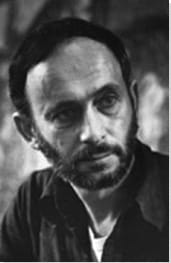Summary of Leon Kossoff
At a time when Conceptualism and Minimalism were dominating the contemporary art scene, Kossoff emerged from within a group of radical figurative painters who became known as "The School of London". Their approaches varied significantly, with Kossoff's work standing out for its heavy impasto style (referred to by one critic as being like "icing on a cake") form which his images appear to physically materialize. Kossoff's paintings ask the viewer to consider simultaneously the image, and the texture and application, of the paint itself. Kossoff was a proud Londoner (he was in fact the only member of the group to be born and bred in London) who's cityscapes focused predominantly on the blitzed post-war city and its dusty construction sites. He complemented his cityscapes with a series of portraits, usually of family and close friends, which Kossoff executed with the expressive and tactile force that was to become his trademark.
Accomplishments
- Emerging in the mid-1970s, Kossoff, with the likes of Frank Auerbach, R. B. Kitaj, Lucian Freud and Francis Bacon, represented a new generation of British art school painters. "The School of London" amounted to an afront to the prevailing avant-gardes and revitalized international interest in figurative painting. Indeed, Kossoff is cited as one of the chief influences on the revival of figurative art as seen in the rise of the late '70s/early '80s movements of Neo-Expressionism and New Spirit Painting.
- Kossoff is recognized for the almost primeval ferocity with which he applied his paint. His style featured heavily reworked paintings and powerful drawings that caught the downcast mood of post-war London. But later works see the artist abandoning his preference for grays and browns. Moving into the 1990s, his outlook on life was no less subjective, but perhaps more spiritual as he turned towards a lighter color palette. His celebrated series of Cherry Tree paintings were a tribute to the changing seasons but also to the "tree of life" itself.
- The publicity adverse Kossoff spoke of his love for London through his unromantic and uncompromising art. Richard Kendall of the British Council, summed him up thus: "His work has affinities with European expressionism, but also has particular English qualities: reminiscent of Sickert and the Camden Town Group of painters with an attachment to the everyday and least picturesque aspects of urban life".
- Having become friends in the 1950s, Kossoff and Frank Auerbach shared a close bond that lasted some 70 years. The pair remained dedicated to figurative art as other movements came and went and the similarities between the two artists is often picked up on by critics and historians. But while Auerbach's preference was to paint on canvas, and his painting can lean closer toward abstraction than his friend's, Kossoff's painting style was so dense he usually opted to paint on board since it could better support the sheer physical weight of the paint.
The Life of Leon Kossoff
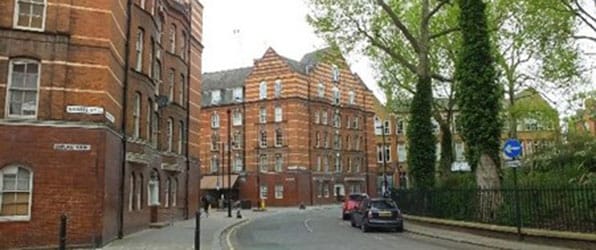
Reviewing an exhibition of Kossoff's early cityscapes, Donald Kuspit wrote, "One can't help but think of William Blake, and the first few lines of his 1794 poem 'London': 'I wander thro' each charter'd street / Near where the charter'd Thames does flow. / And mark in every face I meet / Marks of weakness, marks of woe'".
Important Art by Leon Kossoff
City Rooftops
A native of the city in which he lived all his life, London was the key protagonist in so many of Kossoff's works. As with many of his cityscapes, such as City Rooftops, he focuses on architectural features. In this charcoal drawing, to which he added its layered effect using an eraser, and the heel of his hand, the flattened roofs are outlined in white while the light creeping up on the horizon suggests that this scene is set at dawn, as the city starts to come to life, perhaps. Like many of his early works, there is a strong sense of foreboding here, giving the feeling that the city, in the words of art critic Donald Kuspit, is "suffocating under toxic ash" and that post-war London is "haunted by death". Indeed, many of Kossoff's London 1950s cityscapes reference the aftermath of WWII, not only in the physical sense of buildings being demolished, but also in the psychological sense. As Kuspit put it, "Kossoff's London [...] is depressing, unwholesome, grim; indeed, a kind of hell".
Charcoal and pastel on paper - Annely Juda Fine Art, London, England
Portrait of Mother Asleep
This portrait is of the artist's mother. She is sleeping in a chair with her head supported by her right hand. The painting shows Kossoff's signature technique of creating a heavily worked surface, applying and re-applying his lead paint into a thick impasto. Indeed, Kossoff always painted on board since canvas was too fragile to withstand his vigorous painting approach. On this point the art critic Michael Glover suggests that Kossoff's "pummeling and piling up and wrenching about of paint" was perhaps an extension of the family bakery business where as a boy he would have watched his father knead his dough in a similar vein. Kossoff painted several portraits during his career, mostly of his family and close friends. Says Glover, "These early portraits seem to be in love with an inner darkness, at one with it. They seem to be wrested from that darkness". Like most of his early works, the palette here is full of dark, earthy, muddied hues. Yet the image of his mother is dominated by sweeping swathes of pink and cream paint to suggest skin tone and/or femininity.
Kossoff readily acknowledged the crucial role his tutor, David Bomberg, had to play in the development of his style. Bomberg was well known for encouraging his students to seek out "the spirit in the mass". Having adopted this mantra (he said that his paint came from his bloodstream) Kossoff's painting technique would then represent his own subjectivity and, in this example, his deep feelings towards the very person(s) who gave him life. Kossoff's portraiture has seen him likened, in fact, to the American figurative expressionist, Willem de Kooning.
Oil on board - Private collection
Demolition of YMCA Building No. 2, Spring 1971
This work shows an urban scene in which a YMCA building in London (built in 1911) is being demolished to make room for a hotel complex. We see machinery and workmen active on the site. Curator Arabella Hutter von Arx sees the work as evoking "the images of utter destruction that came out of World War II, while its clotting reds belong to a body, perhaps in the collective, now wholly ravaged". She continues, "In a scene which must have been quite still, objectively, everything moves, pulsates, teems, as if it were a split open torso and its exposed viscera. The painting can be read at once as a devastated geography and a war-torn body".
Yet the work also seems to signal something of a turning point in Kossoff's career. Although the image represents a building site and the demolition of an auguste institution that worked for the betterment of the "mind, body and spirit" of young men, the painting sees the artist turning away from his reliance on a dark and morose palette to present a scene that hints at a sense of optimism and hope. It was a view backed by arts writer Tom Teicholz who warmed to "the energy and vigor of the brushstrokes, and [Kossoff's] strategic use of reds and blues [which] make for a celebration of creation, of rebuilding, of the transformation of London itself".
Oil on board - Annely Juda Fine Art, London, England
Children's Swimming Pool, Autumn Afternoon, 1971
As his career progressed, Kossoff opted for a lighter and brighter color palette and, sometimes, a lighter and brighter subject matter. Here, for instance, he depicts a public swimming pool teeming with bathers. What doesn't change, however, is Kossoff's impasto technique which here brings the image a sense of joyful activity and movement. Kossoff himself stated that his painting was merely "space and light, occupied by human presences" and that this work was "all about space and movement and light [...] every time you look you see something different, you experience something different," he said.
The art critic Gloria Tessler writes, "Kossoff was an artist of his time, who saw in the post-war urbanisation of his local East End a human urgency that expressed the very fabric of the city. He painted Dalston, Willesden Green, Bethnal Green and Spitalfields - the tube station and the swimming pool alike - roughly and intensely, blending humanity into his cityscapes. People and building sites were one and the same. 'London,' he said, 'seems to be in my bloodstream.' Although driven to paint the same people and places - the work was always being recreated, as he strove 'to establish a relationship between his paint and his sensory experience'".
Oil on panel - J. Paul Getty Museum, Los Angeles, California
Christ Church, Spitalfields, Early Summer
As his style grew more luminous, Kossoff returned to sites around London that were of great significance to him, none more so than Christ Church in Spitalfields, in London's East End. In this painting, one of many he produced of the building over the years, the church is delineated with grey lines against a bright blue sky. A green tree stands tall at the right-hand side, and below, pedestrians mill about. Arts editor Michael McNay notes that in works such as this, Kossoff presented the scene "from a child's-eye view [with] the weight of the sky leaning on the building".
He first painted the church in 1986 and, after reading Peter Ackroyd's book about the church's architect, Nicholas Hawksmoor, he revisited the site repeatedly. Kossoff recalled "I walked once again down Brick Lane toward Christchurch, Spitalfields, a building which like St Paul's has always been part of my life and, in the dusty sunlight of that August day, when this part of London still looks and feels like the London of Blake's Jerusalem. I find myself involved once again in making drawings and the idea for a painting begins to emerge". Critic Franklin Einspruch even likened Kossoff's relationship to Christchurch to a "sustained intensity that recalls Monet's serial meditations on the facade of Rouen Cathedral".
Oil on board - Annely Juda Fine Art, London, England
Cherry Tree in Spring
Some of Kossoff's last paintings were a series that showed a cherry tree growing in a garden viewable from his home. The series completes the evolution of his oeuvre; indeed, the crumbling tree itself is symbolic of aging and the ravages of time that were keenly felt by the 89-year-old artist (he had stated publicly in 2012 that he was no longer physically able to paint). Writing five years earlier, Kossoff explained that the Cherry Tree series had focused on a single tree. He wrote: "One large bough [branch] was deteriorating and should have been removed. Instead, we decided to support it with stakes. As time passed it seemed as if the stakes had always been there. This subject, so different from other subjects that I had been involved with through the years, became my working life". In Cherry Tree in Spring is noticeable that the stakes (or crutches) that had held the tree's leaning weight (and which are evident in earlier paintings from the series) are absent. Kossoff's approach here is more mellow and even, and his preference for pastel colors, reflects the optimism that comes with the new dawning of spring.
Commenting on the series, critic Franklin Einspruch wrote, "'Everyone has talent at twenty-five,' said Degas. The trick is to have it at fifty.' So what's the trick? No one ever willed talent into being. (Skill, yes; talent, no.) One can only sow effort year after year and hope that one's creative soil is rich enough to produce. Kossoff, who would be in a position to note that the real trick is to have talent at 85, shows the way. The persistent, vigorous exercise of his gifts has resulted in a visual spring at a time when one might expect an artist's winter".
Writing, finally, on his blog in September 2021, the curator and historian Charles Saumarez Smith explained to his readers how he had just returned from a tea ceremony on the Boundary Estate, Shoreditch, to "celebrate the erection of a sign to mark [the] cherry tree which was planted [to] commemorate Leon Kossoff" and that the artist had come "back several times towards the end of his life to see the neighbourhood where he had spent so much of his childhood". Kossoff himself would have no doubt fully appreciated such a touching and lasting local gesture to his life's work.
Oil on board - Annely Juda Fine Art, London, England
Biography of Leon Kossoff
Childhood
Leon Kossoff was born and raised in the inner London borough of Islington. He was the second of seven children born to working-class Russian-Jewish immigrants. His father, Wolf, a baker, and his mother, Rachel, had moved to London at the start of the century having fled religious persecution in the Ukraine. Kossoff recalled, "there wasn't much culture [in my family] and artists were considered wastrels". Kossoff's first significant encounter with art came at the age of nine when he encountered Rembrandt's A Woman Bathing in a Stream (c. 1654) at the National Gallery. He said later, "I don't know what struck me about it [...] But somehow that painting opened up a whole world to me - not a world of painting so much as a way of feeling about life that I hadn't experienced before".
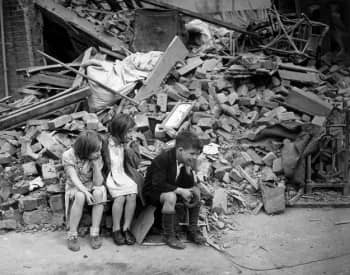
With the outbreak of World War II, children were relocated from inner London to the safety of rural England. The thirteen-year-old Kossoff was taken in by the Bishop family who lived in the market town of King's Lynn, Norfolk (about 100 miles north of London). It proved a good move for Kossoff given that the Bishop's strongly encouraged Kossoff to maintain his interest in art. He still longed for his childhood home, stating later: "The strange, ever-changing light, the endless streets, and the shuddering feel of the sprawling city linger[ed] in my mind like a faintly glimmering memory of a long-forgotten, perhaps never experienced childhood".
Education and Early Training
Kossoff returned to London in 1943, where he studied commercial art at Saint Martin's School of Art, and evening life drawing classes at Toynbee Hall adult education centre. From 1945-48 he completed military service in the 2nd Battalion Jewish Brigade of the Royal Fusiliers, and served in Italy, Holland, Belgium, and Northern Germany. Frank Auerbach was a Jewish war orphan (his parents having perished in the death camps) and was given a job at the Kossoff family bakery on Calvert Avenue (Auerbach served on the bread counter; Kossoff on the cakes counter). Historian Alistair Smart wrote, "In time, the pair would leave the bakery behind and develop long, successful careers as artists, careers that are frequently considered in parallel. Auerbach (repeating a well-known quote by Georges Braque who was reflecting on his working relationship with Pablo Picasso) claimed they 'were like two mountain climbers roped together'".
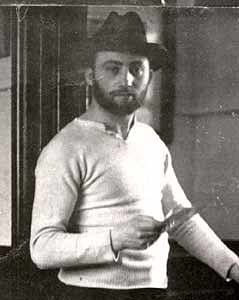
Kossoff (with Auerbach) returned to his studies at Saint Martin's in 1949 but failed an important exam due to his wanting drawing technique. But both he and his friend had already become disillusioned with the College's academic leanings. As Auerbach said in an interview in 1990, "Leon and I were perhaps a bit rougher than the other students [...] We wanted something ... not so linear and illustrative". At Auerbach's suggestion, the pair transferred to Borough Road Polytechnic where they took evening classes with the painter David Bomberg, onetime member of the British avant-garde group, the Whitechapel Boys (they took their name from the Whitechapel Library where they met). The pair studied under Bomberg between 1950 and 1952, and as arts editor Michael McNay explains, Bomberg encouraged Kossoff to establish an "intense visual and emotional engagement with the subject", and to seek out what Bomberg often called "the spirit in the mass". For his part, Kossoff stated that watching Bomberg draw made him feel like he had finally "come home" as a painter.
Between 1950 and 1953, Kossoff also worked out of a studio in Mornington Crescent (in Northwest London), before moving into a space in Bethnal Green (in London's East End). Smart tells us that there are a total of eight portraits of Kossoff by Auerbach, and three by Kossoff of Auerbach painted during the decade. Auerbach recalled "I would sit for an hour and Leon would paint me, and then Leon would sit for an hour and I'd paint him - and so we went on all day, turn and turn about ... I've forgotten how many days a week we did it, maybe two. It may have taken about two years for Leon to finish two paintings of me ... and [the same] for me to finish two paintings of Leon". Smart observes that both men had developed "a habit of applying and then scraping away innumerable layers of paint in the creation of a single work - until, finally, he was satisfied with the result. Often those results have surfaces so thickly encrusted they recall the icing on a cake".
In 1953 Kossoff married Rosalind (also known as Peggy) and took up a position at the Royal College of Art, where he studied for the next three years. In his final year, he was given an exhibition at Helen Lessore's Beaux Arts gallery, which was perhaps one of the most important commercial outlets for British artists in the post war decades. Indeed, the exhibition proved instrumental in launching his career.
By 1959, Kossoff was teaching at three London arts institutions: the Regent Street Polytechnic, Chelsea School of Art, and Saint Martin's School of Art. During this time he moved his studio to Willesden Junction (Northwest London) and, having rued that "photography has made it difficult for us [figurative painters] to experience the presence of painting", continued to paint with Auerbach, and to exhibit variously with Francis Bacon, Lucian Freud, R. B. Kitaj, and Keith Critchlow. Kossoff created paintings with a near hyperbolic intensity with paint layered so thickly the image buckled under its own weight. As Andrea Rose, former director of visual arts at the British Council, observed, "There is a sense of struggling with this huge weight of lead paint [...] in quantities I think nobody had used before, and I think the struggle for him was trying to make this viscous material response to what he was feeling about what he was seeing".
Mature Period
In 1976, Kitaj curated the now famous "Human Clay" exhibition at London's Hayward Gallery. It has gone down in history as one of the turning points in late 20th century art. The "Human Clay" catalogue featured an essay by Kitaj in which he introduced the term "School of London". The definition referred to a cadre of London-based artists including Kossoff, Auerbach, Kitaj, Freud, Bacon, and David Hockey (who was, in fact, based in Los Angeles). Collectively they had countered the fashion amongst avant-gardists for Minimalism and Conceptualism and reinvigorated the critical fortunes of figurativism.
The School of London artists frequently met at the Colony Room Club in Soho, a somewhat insalubrious members-only drinking club (founded by artists' model Muriel Belcher in 1948). The introverted Kossoff, however, attended infrequently, preferring to spend his time in his studio, wandering the streets of London, or at home, or at the public swimming baths with his wife and young son. However, Kossoff and Freud did form a close connection based on their shared belief that direct observation was crucial to their art, with both men committed to drawing and painting from real life. Commenting on his similarities to Freud, critic Clare Hurley wrote "Like Lucian Freud, grandson of psychoanalysis's founder Sigmund who had likewise taken refuge from Nazism in London, Kossoff was known for always working with a model, never from a photograph. His models, often friends or family members, sat for hours, days, even years for his portraits. Kossoff remarked that 'every time you look, you see, you experience something different. In the end, the differences amount to a sort of presence.' Perhaps both artists' insistence on creating presence by returning again and again to a model that was always changing owed something to their common experience of displacement, loss and absence".
Late Period and Death
Kossoff finally received the full recognition he deserved in 1995 when was selected as the artist to represent Britain at the Venice Biennale. He did not win over every critic, one dismissed him as "irrelevant"; another described his work as "a footnote to history", but in 1996 London's Tate Gallery held a triumphant retrospective of his work. Now moving into his twilight years, Kossoff's palette became softer and his work more in tune with nature and his own mortality. This shift is most evident in a series of paintings focused on a single, and ailing, cherry tree. Reflecting on his career, Kossoff insisted that his life's work had "been an experiment in self-education" and that even in the later stages of his life he still did not "seem able to do a drawing".
Kossoff was a private figure, declining to give interviews, or even have his face shown in publicity materials. He was modest, too, ignoring career recognition from the state by turning down a CBE medal. Kossoff continued to produce (albeit more intermittently) and exhibit work, both nationally and internationally, until he passed away due to complications of a stroke in 2019, at the age of 92. He was survived by his wife, their son David, four grandchildren, and two great-grandchildren.
The Legacy of Leon Kossoff
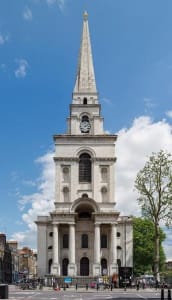
As a member of the School of London, Kossoff undertook the critical work of re-examining painting during the post-war period, and championing figurative painting at a time when abstraction was gaining popularity. Says art critic Jonathan Jones, "Whatever it is that makes art profound, they [The School of London] have it. They are the true heroes of modern British art". On an individual level, Kossoff is today recognized as one of Britain's preeminent figurative painters. Art critic Roberta Smith referred to him as one of "the most accomplished painters of the late 20th and early 21st century" and suggested that he had been "unfairly overshadowed by fellow British artists like Francis Bacon and Lucian Freud, thanks in part to their colorful personal lives".
Smith contends that "Kossoff's greatness lies in the extreme way he pits the two basic realities of painting - the actual paint surface and the image depicted - against each another [...] First there is the startlingly heavy, even off-putting, impasto of his oil paint, which sometimes seems more ladled on than conventionally applied with a brush (even a big one), and which gives his surfaces an almost topographical dimension. Then there is the reality of his images, initially swamped in paint, that ultimately battles its way to legibility through a process that thrillingly slows and extends the act of looking". Speaking shortly after the artist's death, finally, critic Tom Teicholz endorsed this sentiment: "Kossoff reminds us of the tonic and potency of rebuilding and that art can be a celebration unto itself".
Influences and Connections

-
![Frank Auerbach]() Frank Auerbach
Frank Auerbach -
![Rembrandt van Rijn]() Rembrandt van Rijn
Rembrandt van Rijn -
![Vincent van Gogh]() Vincent van Gogh
Vincent van Gogh -
![Nicolas Poussin]() Nicolas Poussin
Nicolas Poussin ![David Bomberg]() David Bomberg
David Bomberg
-
![Francis Bacon]() Francis Bacon
Francis Bacon -
![Lucian Freud]() Lucian Freud
Lucian Freud - Keith Critchlow
-
![Impressionism]() Impressionism
Impressionism -
![Expressionism]() Expressionism
Expressionism -
![Fauvism]() Fauvism
Fauvism -
![School of London]() School of London
School of London - Post-Expressionism
-
![Jenny Saville]() Jenny Saville
Jenny Saville -
![Cecily Brown]() Cecily Brown
Cecily Brown - Richard Cook
-
![Francis Bacon]() Francis Bacon
Francis Bacon -
![Lucian Freud]() Lucian Freud
Lucian Freud - Keith Critchlow
-
![School of London]() School of London
School of London -
![Neo-Expressionism]() Neo-Expressionism
Neo-Expressionism - New Spirit Painting
Useful Resources on Leon Kossoff
- Leon Kossoff: From the Early Years, 1957-1967Our PickBy Al Alvarez
- Leon Kossoff: A Life in PaintingBy Andrea Rose, Peter Goulds, and David Juda
 Ask The Art Story AI
Ask The Art Story AI